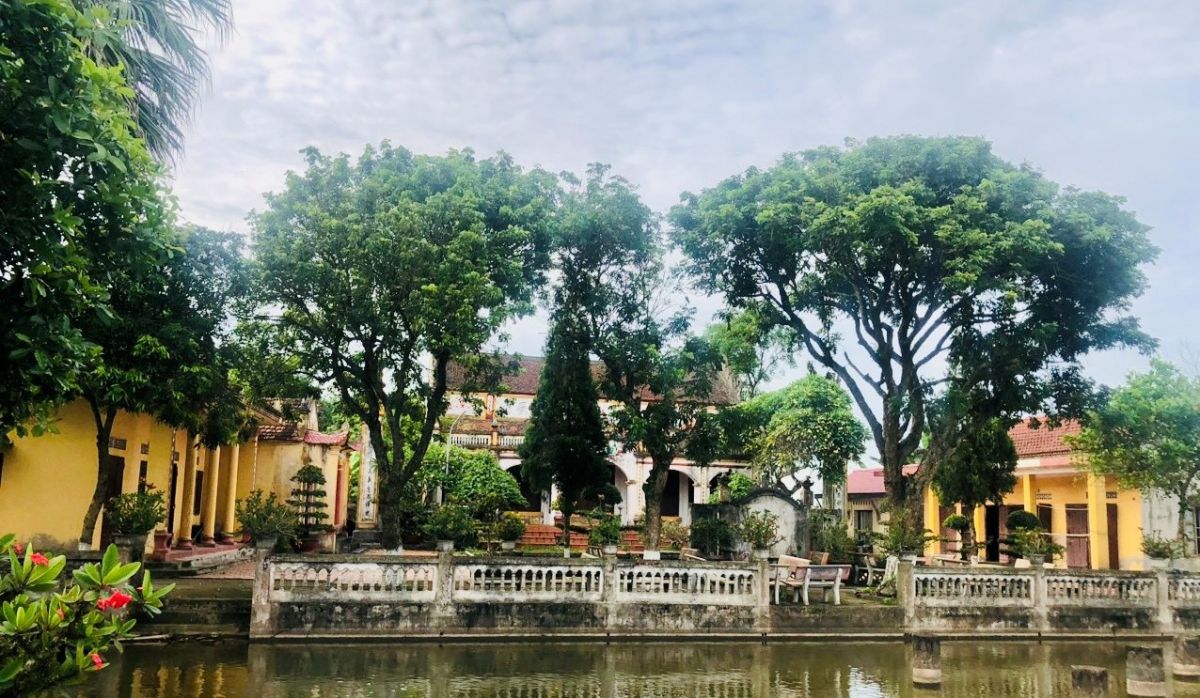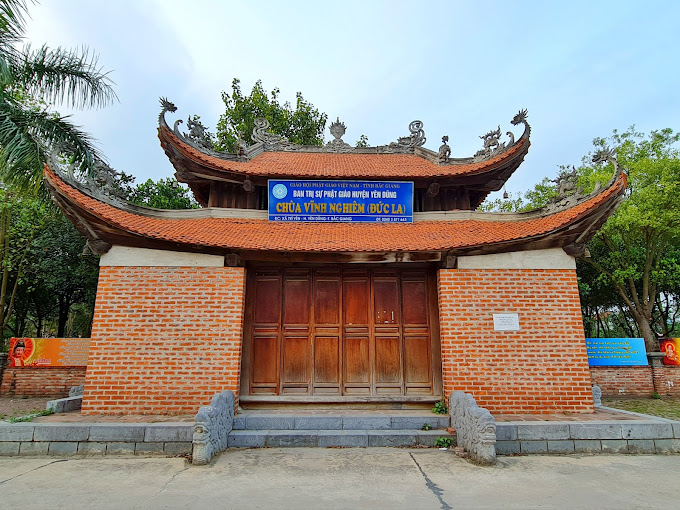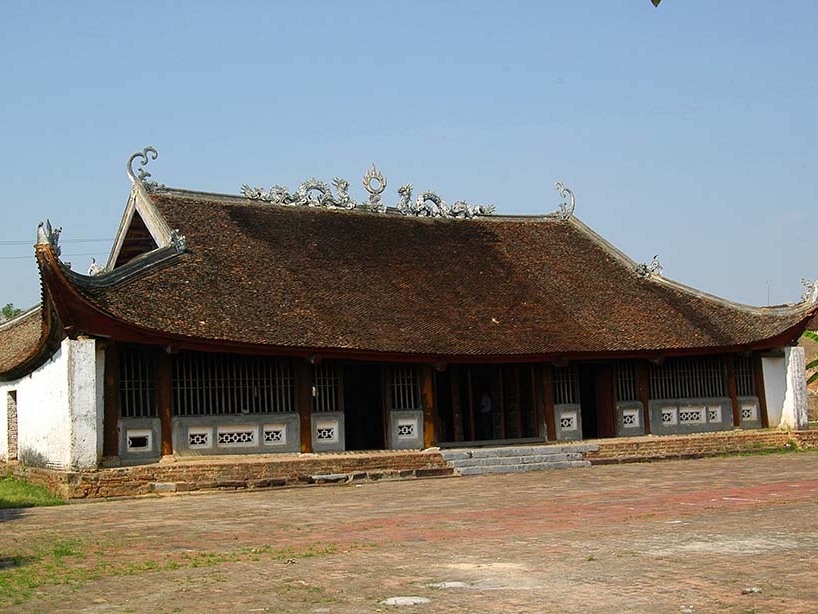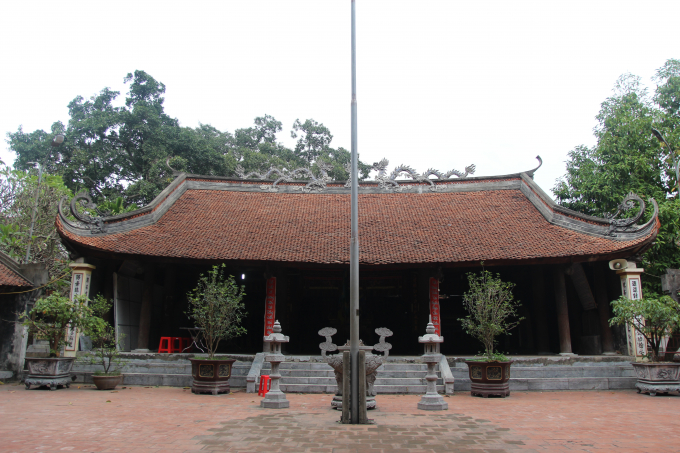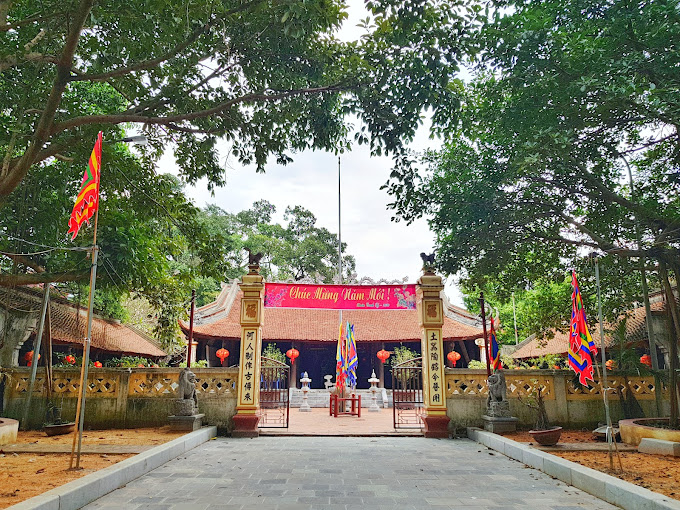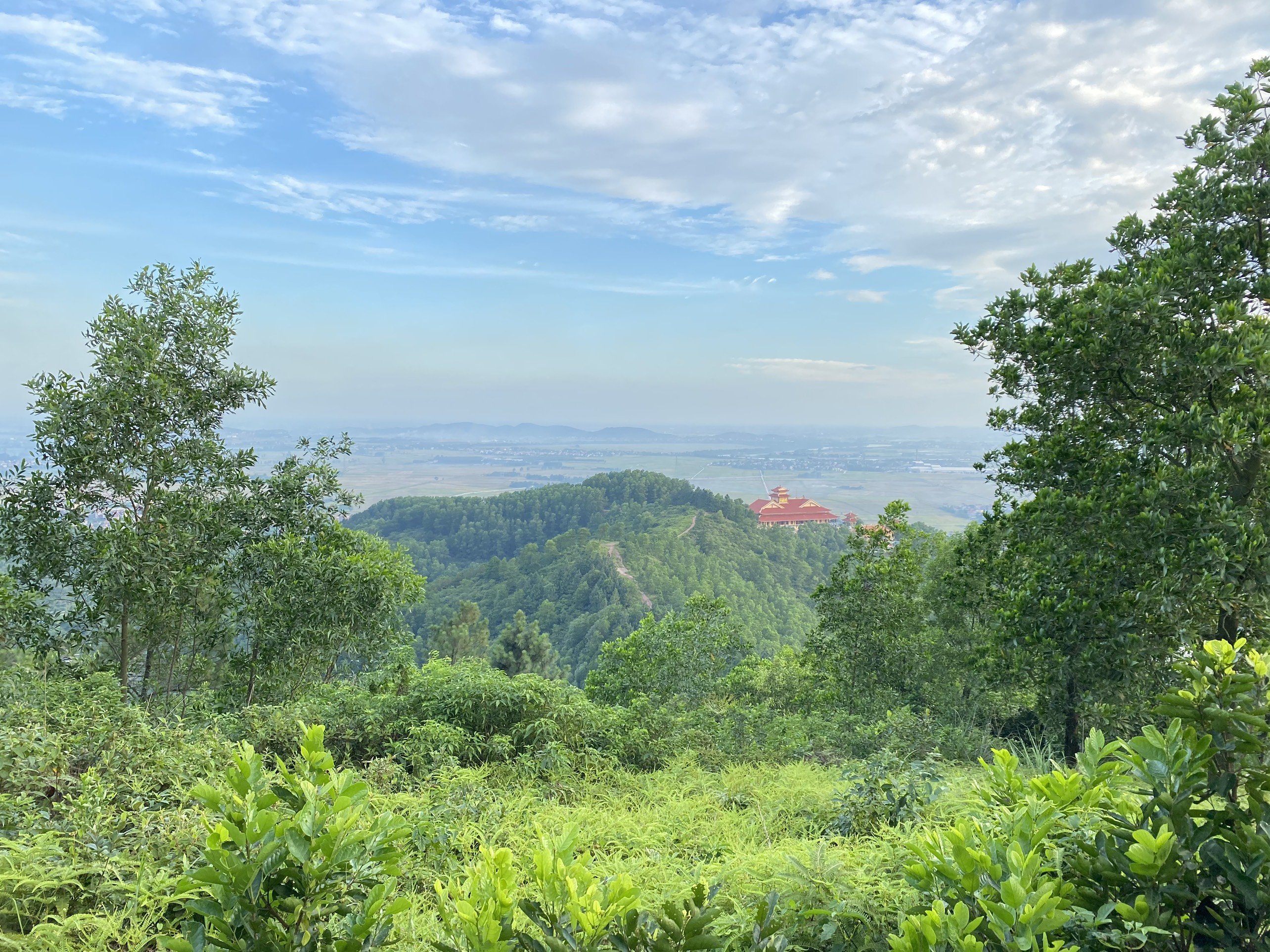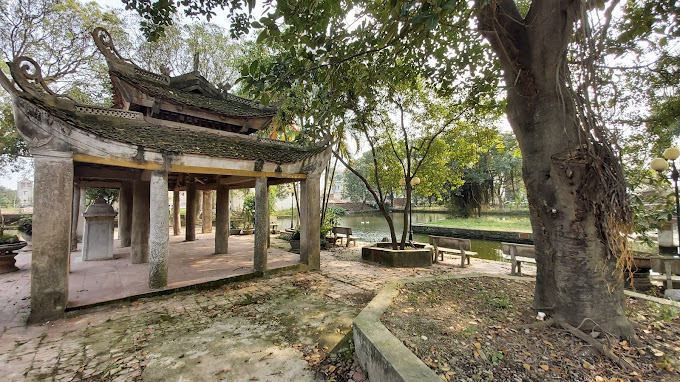Relic point Vietnam
Việt NamDo Xa pagoda
Do Xa Pagoda is located in the center of Do Xa neighborhood, Ninh Xa ward, Bac Ninh city. Do Xa Pagoda was built at the end of the 18th century. The pagoda worships Buddha and Arhats. Do Xa Pagoda was ranked as a National Historical and Architectural Monument in 1992. The pagoda has a beautiful landscape and architecture, is designed and decorated in a traditional style, with exquisite decorative carvings. cunning, art. The system of Buddha statues and worship objects in the temple have the typical style of each period and the talent of the artisans. The Three Jewels Court of Do Xa Pagoda currently has Dinh-style architecture including the 5-compartment Front Street and 4-compartment Upper Palace. The door system is opened in all 5 rooms facing southwest in the style of a table door. From the yard to the foundation of the Tam Bao temple are 7 steps made of green stone. The pagoda's roof is tiled, and on the top of the roof is embossed the name of the pagoda "Quang Minh Tu" in Chinese characters. The pagoda is built in the style of a vase with the head and arms resting on the throne. On both sides of the front gable of the Tam Bao gate are two bronze pillars, on the pillars are covered with parallel sentences in Chinese characters. Besides the main building, the Tam Bao temple, within the pagoda's grounds, there are also the Tam Quan buildings, the Patriarch's house, the model house and the monk's house, all built in a traditional appearance, in harmony with the architecture of the temple. main project with spacious and perfect beauty. Currently in the pagoda, some typical artifacts are still preserved such as: Stele "Linh bi do tu bi ky", dated Vinh Thinh 2 (1706); Stele "Epic of the Late Buddha", dated Tu Duc 29 (1875); Stele "Epic of the Late Buddha", dated Tu Duc 29 (1875); Late Buddha stele inscription, dated Tu Duc 29 (1876); 1 bronze bell cast in 1898; Buddha statues of the Nguyen Dynasty (19th century). Do Xa Pagoda Festival takes place from the 13th to 15th of the first lunar month. The pagoda has long been the center of religious and belief activities in the spiritual life of many generations of people here, contributing to educating and promoting solidarity in the village community, helping people to move forward. good eliminates evil. Do Xa Pagoda and Do Xa Communal House are located adjacent to each other, forming an architectural complex with open space without walls, allowing ventilation with the surroundings. According to the inscription, Do Xa communal house was built a long time ago. During the reign of Le Trung Hung (18th century), the communal house was restored on a very large scale with splendid carvings of "four sacred animals and four precious things". But over the years, the communal house has been restored and embellished many times. Currently, Do Xa Communal House is a newly restored architectural work, but still retains the carvings of the Le Trung Hung period with the sophisticated artistic "Cloud Dragon". Do Xa Communal House also preserves valuable antique documents such as a system of divine legends and stone steles that clearly reveal the history of the communal house, as well as the people being worshiped. The "Miracles of Divine Beauty" of Do Xa Communal House declared in 1938, copied by the Institute of Social Science Information, states: Do Xa Communal House worships Saint Tam Giang (Truong Hong, Truong Hat) who had the merit of fighting the enemy. Luong in the 6th century and also recorded the content of some of the ordinations of Saint Tam Giang that were worshiped in the village communal house. Source: Bac Ninh province electronic information portal
Bac Ninh 3888 view
Temple of Nguyen Phuc Xuyen
From the Nguyen family street - also the famous temple of Nguyen Phuc Xuyen in hamlet 7 (now area 7 of Dai Phuc ward, Bac Ninh city, Bac Ninh province). Famous person Nguyen Phuc Xuyen is famous for his unusual way of treating diseases and saving people and his doctrine of Gia Dao - a teaching whose influence is still present today in the spiritual life of the family's descendants. The temple worshiping the famous man Nguyen Phuc Xuyen, called Bodhisattva Linh Tu, was built on a large area of land in the middle of Dong Pheo village, Dai Vu commune, Do Xa district, Soc Giang district, Tu Son district, Kinh Bac region in the past. The temple faces Southeast, in front is a strip of sunken fields named Dong Nhan; There is Ngu Huyen River meandering around, further away are Ba Huyen, Moc Hoan, and Bat Qua Bo Son mountains. Behind is Vu Son mountain next to Nhu Nguyet stream. This is originally the birth and birth part of the Heavenly Master Great Bodhisattva - the religious name of the famous man Nguyen Phuc Xuyen. According to historical documents, Nguyen Phuc Xuyen temple was built in the 18th century. The family genealogy says that initially the temple was the house of Mr. Nguyen Phuc Xuyen. After his death, the house became a temple. In 1768, Nguyen Phuc Giam, the fourth generation grandson of Quy Chi branch, ordered it to be repaired. Over time, this relic has been restored and repaired many times, becoming more and more spacious and perfect with a scale including: Majestic and beautiful Tam Mon Gate; The main building includes 5 pre-worship spaces and 3 back palace spaces; On both sides are arranged the left vu, the right vu, the model house, behind is his tomb. There is a lake in front, the season is bright with lotus and water lilies. The unique feature of the monument is its architecture: First is the temple, then is the tomb. This architectural style started from the Le dynasty. That is a form of being influenced by the "dispassionate" religion of forgetting the mundane world. The main worship building has a Dinh-shaped architecture consisting of 5 pre-worship rooms and 3 back rooms, with an ironwood frame, the structure of the roof is in the style of a gong stand, and the two side rooms are in the style of a stack of beds. The architectural structures are carved with cloud dragons, artistic flowers and leaves, and are decorated with a system of grand characters, horizontal panels, and multi-layered thick engravings of Chinese characters. Nguyen Phuc Xuyen - his personal name is Te An, his religious name is Heavenly Master Great Bodhisattva, also his religious name is Han Thiet, born in the year of Quy Suu, in the 13th year of Hoang Dinh during the reign of King Le Kinh Tong and Lord Trinh Tung (1613). in a family of Confucian lineage who studies, admires Zen and makes medicine in Dong Pheo village, Dai Vu commune, Do Xa district, Soc Giang district, Tu Son district, Kinh Bac region (now Dai Phuc ward, Bac city). Ninh). His fifth-generation ancestor was Bachelor Nguyen Tien Tu, nicknamed Thuan Chinh, his father was Nguyen Phuc Khanh. According to genealogy and family tradition, the ancestor of the Nguyen Phuc family in Dong Pheo was a cultural celebrity - Ly dynasty's national teacher Nguyen Minh Khong - a big name in the Vietnamese Zen village, with many legends surrounding it. The folk-woven act of curing King Than Tong's illness and donating bronze to cast a bell, created one of the four great qi of An Nam. Holy Patriarch Nguyen Phuc Xuyen had a handsome appearance when he was born. He grew up with a poise and intelligent temperament. He was a calm, clean, and dignified person who did nothing other than study. Through that, knowledge gradually expanded, far surpassing ordinary people. But he did not take that as a way to advance his career, but devotedly followed Buddhism, burning incense early and late in the evening to be respectful. Along with that, focusing on studying Lao Tzu's philosophy gave him insight into the mysteries of creation, and knew many mystical methods in the practice of healing and saving people later. He was honored by the Le - Trinh court as the National Protector of Zen Master and Bodhisattva Saint, and was revered by the people as Living Buddha (living Buddha). Not only is he good at Buddhism, Confucianism and Lao Tzu philosophy; but he also united the thoughts of the three religions of Buddhism - Taoism - Confucianism to propose a new religion - called Nhat Dao, or Gia Dao. This is a creation of Nguyen Phuc Xuyen to apply the spirit of cultivating humanity and doing good deeds to help people in the historical situation of the Le - Trinh period full of chaos and chaos. Source: Bac Ninh Province Literature and Arts Association
Bac Ninh 3780 view
Bac Ninh Temple of Literature
Bac Ninh Temple of Literature is one of six temples in Vietnam, with historical and cultural value, reflecting the academic tradition of the Kinh Bac countryside through the periods of building and defending the country under feudal dynasties. Bac Ninh Temple of Literature is the pride of the homeland's academic tradition and is an attractive tourist destination for tourists inside and outside the province. Bac Ninh Temple of Literature was built on Phuc Son mountain, in area 10, Dai Phuc ward, Bac Ninh city. The Temple of Literature was built before the Nguyen Dynasty (at the latest in the Le Dynasty), to worship and worship "Confucius" - who was honored as "Holy Master" or "Van The Master Bieu" and Tu Pham - the monks. The sages of Confucianism are Nhan Hoi, Tang Sam, Tu Tu, and Mencius (who are jointly worshiped with Confucius). The overall project of the Temple of Literature in Bac Ninh currently includes: Nghi Mon Gate, the Pre-Test Court with 5 compartments and 2 compartments, on the 2 sides of the Hau Duong are 2 Bi Dinh buildings with 5 compartments and 2 compartments, on the 2 sides of the Pre-Test Court are 2 Ta Vu - Huu vu, in the main yard between Nghi Mon gate and the front altar, set up a screen stele. Every year, on the full moon day of the first lunar month, an incense offering ceremony is held at the Temple of Literature with the participation of the provincial leaders to commemorate our ancestors and pray for peace and prosperity for the country and Bac Ninh province. , the education career is increasingly progressing. This place also often welcomes delegations of national and international excellent students from Bac Ninh province to offer incense and report their achievements after each exam. The relic gate is built with three gates, pillars with lanterns, two pillars in the middle of the communal house are covered with phoenixes to form a winch, two pillars on the sides are placed to flank the temple. Around the lantern, the main panels emboss the Four Spirits and Four Quarters bong channel. The stone stele (screen stele) erected in the middle of the Temple of Literature yard "Bac Ninh province restored the Temple of Literature Bi Ky" (Stele records the restoration of the Temple of Literature in Bac Ninh); It is nearly 10m2 in size and is considered a treasure of the Temple of Literature. The stele praises the role and significance of the Temple of Literature, as well as honors talented people. The center of the relic is the Tien Te building consisting of 5 compartments and 2 compartments, built on a brick foundation 55 cm higher than the yard. In front of the door is a table with three middle compartments, and two side compartments with doors shaped like the word Tho. The two walls are built of bricks in the style of a square-shaped square, connecting wind wings, lantern pillars, and a spread-out communal house. The roof is built with thread, the two ends are covered with dragons, in the middle are a pair of dragons flanking the moon. The back hall is next after the front hall and is connected by a bridge to form the word Cong. The 5-room Hau Duong House is carved with the Four Quarters. The back hall is a place to worship Zhou Cong, Confucius, and Tu Phoi. Connecting the two gables of the Hau Duong house, on the right is a stele house, on the left is the Tao Huong house, each building has 4 rooms, built on a brick foundation lower than the Hau Duong house. Architecture follows the style of pulling pincers and spreading rackets. The two houses, Ta Vu and Huu Vu, were built along both sides of the front yard of the front yard, each row had 4 rooms, two compartments, simple architecture in the style of a rectangular vase, brick walls, tiled roof, and open paneled doors in the middle space. The outstanding feature among all the remaining values of Bac Ninh Temple of Literature are the 15 stone steles. Among them, 12 "Kim Bang Luu Phuong" steles were built in 1889, honoring nearly 700 great scholars from Kinh Bac hometown who brightened the tradition of studious academics and contributed to the cause of construction and protection. country, developing Vietnamese culture. Source: Bac Ninh province electronic information portal
Bac Ninh 4220 view
Do Temple and Tombs of Ly Dynasty Kings
The tombs and temples of the Ly Dynasty Kings are historical evidence of the ancient Co Phap village and today's Dinh Bang; It is a relic land, a temple to worship the Ly dynasty kings and is also the burial place of the Ly dynasty's ancestors and royal family. Ly Dynasty (1009 - 1225), from when Thai To (Ly Cong Uan) ascended the throne, moved the capital from Hoa Lu to Thang Long (1010), experienced 8 kings, passed the throne for 216 years, was the period when the state conferred independence, autonomy, and strength, the people can live in peace and prosperity. The relic site is a unique architectural work, with stone carving, wood carving, worship statue carving, and construction techniques all reaching a sophisticated level and many intangible cultural heritage values being preserved. : worship beliefs, festivals, customs, practices.... The tomb area of the Ly Dynasty kings is also a particularly important archaeological site serving scientific research. The relic has many other names, such as Do Temple, Co Phap Dien/Ly Bat De Temple and Tombs of Ly Dynasty Kings (Tho Tomb Thien Duc or Son Mau Forbidden Land); Includes 2 main areas: Do Temple and Tombs of Ly Dynasty Kings (Forbidden Land). 1. Do Temple: total area of 31,250m2, divided into inner city and suburban areas. Suburb: 26,910m2 wide, including semicircular lake, water pavilion, writer's house on the right, martial arts house on the left. Inner city: 4,340m2 wide, divided into interior and exterior areas. The interior includes: the harem, the carriage house, the altar house, the stele house and the house for 8 altar palanquins, the house for 8 worship horses on both sides. The exterior includes: Phuong communal house, King's temple, celebrant's house, guest house, exhibition house, hall, five dragon gates, temple yard, elephant statues, stone crocodiles... 2. Tombs of Ly Dynasty Kings (Forbidden Land) The tomb area is the final resting place of the Ly dynasty kings, about 800m northeast of Do temple, located in Sen Pond area, in the fields of Dinh Bang ward, Tu Son town, Bac Ninh province. Today, the tombs of the Ly Dynasty kings include the following buildings: - Tomb of King Ly Thai To - Long Chao Tomb - Tomb of Ca (King Ly Thai Tong) - Tomb Two (also known as Tomb Con) worships King Ly Thanh Tong - Tomb of the Elephant (King Ly Nhan Tong) - Tomb of Duong Gio (King Ly Than Tong) - Tomb of Duong Thuan (King Ly Anh Tong) - Tomb of King Ly Cao Tong - Tomb of King Ly Hue Tong - Mausoleum of Mrs. Nguyen Phi Y Lan - Phat Tich Tomb (Pham Thi's mausoleum) There are not many artifacts left at the Do Temple relics and the Ly Dynasty kings' mausoleum area, such as 8 tablets with the names of the Ly kings painted in red and gilded, carved in the Le dynasty, bronze tops, and cranes. bronze and some bowls and dishes dating back to the Le dynasty. In particular, there is a stone stele, dated 1604, compiled by Dr. Phung Khac Khoan, recording the merits of the Ly kings. In addition, cultural activities of folk beliefs and worship of Ly dynasty kings are still maintained and become traditions at Do temple. Every year, three main festivals take place in Dinh Bang: - Temple festival on January 7. - The communal house is held on February 15, taking place on 2 main days (from February 14 to 15). - Temple festival on March 15, held at Do temple. With special value, the historical site of the Ly Dynasty kings' tombs and temples was ranked a special national monument on December 31, 2014 by the Prime Minister. Source: Department of Cultural Heritage
Bac Ninh 5568 view
Vinh Nghiem Pagoda
Vinh Nghiem Pagoda, also known as Duc La Pagoda, is an ancient pagoda in Duc La village, Tri Yen commune, Yen Dung district, Bac Giang province. Vinh Nghiem Pagoda is an ancient pagoda, where the only original set of woodblocks of the Truc Lam Buddhist sect is kept. The 3,000 woodblocks of Vinh Nghiem Pagoda have been awarded by UNESCO as a world memory documentary heritage. The pagoda is recognized as a Buddhist center, a place to train monks for the whole country, and the birthplace of the Three Patriarchs of Truc Lam Zen sect of Vietnamese Buddhism. In 2015, the pagoda was recognized by the State of Vietnam as a special national monument. Vinh Nghiem Pagoda is located at the confluence of Luc Nam and Thuong rivers (called Phuong Nhan junction). The pagoda overlooks the confluence of rivers, towards Luc Dau Giang - Kiep Bac, Cam Ly region, the gateway to Yen Tu mountain. Surrounding the pagoda are mountains, including Co Tien Mountain. Across the river is Tran Hung Dao's royal palace, Kiep Bac Temple. Legend has it that Vinh Nghiem Pagoda was built in the Ly Dynasty (11th century). At the end of the 13th century, (1010-1028), Buddha Emperor Tran Nhan Tong expanded and built this place into a major Buddhist center of the Tran Dynasty, renaming the pagoda Vinh Nghiem, associated with the birth and development of Truc Lam Yen Tu Zen sect. As one of the ancestral places of the Zen sect, Vinh Nghiem Pagoda was built with a grand architectural scale, many items, standard and exemplary of traditional pagoda architecture. This is an ancient temple with the richest architecture of Buddhist-Vietnamese identity that no other temple in the region has, worthy of being called a "great ancient site". In the pagoda, there are also Buddha statues, statues of the Patriarchs of the Truc Lam lineage, statues of later monks, statues of Dharma protectors, statues of Arhats... In the pagoda there is also a muzzle nearly half a meter long, painted glossy black, with a sound hole. There are two lines of Sanskrit inscriptions. In the past, Vinh Nghiem Pagoda was a place to train Buddhist monks, so it was a storage place for ancient scriptures that were up to 10 rooms wide. These are collections of sutras dating back 700 years, a treasure trove of extremely valuable ancient books, such as: The novice monk, the monk, the novice monk, the 348 precepts, the Yen Tu diary from the 15th century (the process of forming the Truc Lam sect), Hoa Nghiem Sutra, Amitabha Sutra, Mahayana Chi Quan, Precepts and Ni Sutras... Today there are many wooden shelves printed with historical sutras still at the pagoda. The ancients called this engraving, proving that Vinh Nghiem Pagoda once dominated 72 forests. Currently, the Moc Thu warehouse still preserves 34 books with nearly 3,000 engraved copies, each copy has two sides, each side has 2 upside-down engraved pages (negatives) with about 2,000 Nom and Chinese characters. Those engravings are still handed down in our country with each sharp and delicate handwriting. Today, those values still remain intact, without any loss of value. The pagoda's area is about 1 hectare, surrounded by dense bamboo. Currently, the pagoda is being renovated and creating favorable conditions for tourists to travel and worship. Visitors can follow the route such as: three-entrance gate, go about 100m deeper to worship the road, also known as Ho Pagoda. On both sides of the pagoda's road, pine clumps about 1 meter long were built to form pine forests. On the temple grounds there is a large stone stele with 6 sides built in the 7th year of Hoang Dinh (1606). Right in front of the ancient stele is the tomb tower garden of 5 monks: Phu Lang Trung Phap (named Sa Mon), Thong Due Ung Duyen, Thanh Quy, Tinh Phuong Sa Mon, Thanh Hanh and a number of other towers. Vinh Nghiem Pagoda Festival is held on the 14th day of the second lunar month. Source: Bac Giang Province Electronic Information Portal
Bac Ninh 5312 view
Phuc Long Communal House
Phuc Long communal house is located in Tang Tien commune, Viet Yen district, Bac Giang province. Phuc Long communal house is the center of traditional religious and cultural activities of the people of Phuc Long village, past and present. The village communal house is a place of worship for the entire people, and is also the center for organizing the village's festivals during Tet holidays, which represent the long history and cultural traditions of Phuc Long village. Based on the legend engraved on the stone stele of King Tu Duc, and according to the legends of the local people, Phuc Long communal house worships the gods of sound and inspiration, helping to fight the enemy to save the country and protect the country. defend the homeland. In addition, Phuc Long people also worship Nhue District Cong Le Tuong Cong, the Le Dynasty mandarin who helped people rebuild Phuc Long pagoda and communal house. That is the communal house and pagoda that remains today. Remembering his gratitude, the villagers carved a stele recording his merits and worshiped the mandarin as his successor. Every year, they worshiped him on the 10th day of the 7th month, called the death anniversary of the old man. The eulogy of the general's official was read on the death anniversary. They share a common belief in worshiping Heaven, Earth and Water - elements closely related to the lives of people working in wet rice agriculture. The value of Phuc Long communal house is not only in its ancient founding date, over 300 years ago, but mainly in its large scale, unique architectural style and talented carving and decoration art. , delicate. The most attractive thing about Phuc Long communal house is the decoration and engravings on the architectural parts: such as on the ends, levers, scrolls, hammock doors in front of the palace, on the gates, The column bibs (also known as column tapers), are all engraved with decorative images with many different designs. Unlike many other communal houses, the entire wooden frame of Phuc Long communal house is bare, unpainted and gilded, showing off all the sophistication and ingenuity of the workers who built the communal house. What is recognizable is the architectural structure and especially the carvings, showing the two unions of carpenters involved in building the communal house. Therefore, the architectural style, especially the carving, shows two different styles, delicate carving, trimming, elaborate and soft lines. But all of them blend together in unity, richness and diversity, reflecting the most common features of architectural art and engravings of the Le Dynasty in the late 17th century, imbued with folk art: Innocence, generous. Popular decorative shapes are the carvings, carvings of the "four sacred animals", "four precious" images with variations of dragon, Nghe, phoenix, tiger face, dragon-shaped, physical-chemical... extremely rich. Phuc Long communal house was officially recognized by the Ministry of Culture and Information as a national historical and artistic relic in 1993. Source: Electronic Information Portal of Viet Yen Town, Bac Giang Province
Bac Ninh 5338 view
Hoang Mai communal house - Hoang Ninh commune
Hoang Mai communal house relic belongs to Hoang Mai Village, Hoang Ninh Commune, Viet Yen District, Bac Giang. Hoang Mai Communal House is a place to worship Princess Thieu Duong (8th daughter of King Le Thanh Tong - a wise and virtuous king in the years 1460-1497) and her husband (Pham Duc Hoa, son by Pham Van Lieu - a Binh Ngo general who founded the country and was a hero of Le Loi who had many meritorious services to the people and the country in the 15th century). Hoang Mai Communal House was built at the end of the Le Dynasty and the beginning of the Nguyen Dynasty. During the resistance war against the French, implementing the strategy of retreat and defending Hoang Mai Communal House was destroyed by the resistance. In 1949, the communal house was repaired and renovated by the people, making it a sacred place of worship with solemn ceremonies to honor the Thanh Hoang of their village. Through historical periods, despite suffering many destructions from nature and invaders, the village communal house has been protected, restored and embellished, a concentrated and lively expression of the fine traditions of the Hoang people. Mai always respectfully worships and is grateful to those who have contributed to the village and the country. That is the ethical tradition "When drinking water, remember the source", "When eating fruit, remember the person who planted the tree" of the Hoang Mai people in particular and of our nation in general. In 1993, Hoang Mai Communal House was recognized by the Ministry of Culture, Information and Sports. The sport is ranked as a national historical-cultural relic. According to Ngoc genealogy and legend, the location of Hoang Mai communal house is where the body of Princess Thieu Duong (8th daughter of King Le Thanh Tong) floated down the river and stopped here, being picked up and buried by Hoang Mai people. and built into a grave. This is an open-air worship place, built on a brick pedestal, with an incense burner and an old tree. According to the remaining traces such as the Le Dynasty bricks, the traces of the gate, the yard floor, and the people's stories, it shows that there used to be a small temple called the Princess Temple. The communal house looks south on high ground in the northeast of the village, in front there is a communal pond (remains of an ancient river), walking up to the communal gate there is an ancient thi tree. Through the tiled yard shaded by the Thi tree, you will reach the great communal house consisting of 7 rooms built of bricks, tiled roofs, and wooden frames in the style of lines, pillars, and pillars. The two main doors have statues carved with dragons, flowers and leaves, stylized... The worship part is located in the harem building with 3 compartments, making the ancient architecture unconventional. The solemn worship objects of the ancient communal house still remain such as the throne, altar, candle, temple tree, ceramic incense vase, fortune vase... Especially in the communal house, there are also great pagodas and engravings of the jade genealogy of the mausoleum. The solemn hanging wood in the communal house dated "Revelation of Four Years" (1919) clearly shows that it is a place to worship Princess Thieu Duong. Along with the jade genealogy, these precious worship objects are precious antiques and important historical sources to help learn about the gods worshiped at the village communal house and the history of Hoang Mai village in particular. of Viet Yen district, Bac Giang province in general. Every year, to show respect and remember the gratitude of Princess Thieu Duong and the village's blessings, the "Spring and Autumn Second Anniversary" on the 12th day of the 8th lunar month, the people of Hoang Mai village organize worshiping ceremonies. , organizes festivals with healthy cultural and artistic activities, imbued with national cultural traditions and rich in humanity. Source: Electronic Information Portal of Viet Yen Town, Bac Giang Province
Bac Ninh 3352 view
Tho Ha Communal House
Tho Ha communal house is located in the middle of Tho Ha village, Van Ha commune, Viet Yen district, Bac Giang province. The communal house was officially recognized by the Ministry of Culture as a national monument on January 13, 1964. Tho Ha Communal House is a famous communal house of Kinh Bac, built in 1692, during the reign of King Le Hy Tong. Tho Ha Communal House represents the spiritual and cultural space of Vietnamese people with its characteristic and unique architecture. Tho Ha Communal House is associated with the village's Tutelary God, Thai Thuong Lao Quan. According to the village legend, he was a Northerner, lived during the time of King An Duong, surnamed Ly, name Dam (also known as Lao Dam, Lao Tzu). He was credited with killing the Xich Ty demon enemy and opening a school and teaching in the village. He was honored by the King as the Supreme God and the Supreme Tutelary God, allowing Tho Ha village to set up a temple to worship. Therefore, the villagers honored him as the Tutelary God, supporting the peaceful and happy lives of the villagers. The communal house has a large scale and a relatively complete architectural structure. The carved panels show a clear and unique style of the Le Dynasty. The themes expressed on the architectural structures are mainly "four sacred animals" stylized flowers, leaves, birds, animals and people. The dragon at Tho Ha communal house is carved in many parts: the head, the trap, the rod, the cone, the plank, the first verse with the themes of nest dragon, mother dragon carrying baby dragon, dragon and young woman... Tho Ha communal house currently consists of three houses: the front house, the main house and the back palace. The altar consists of 3 rooms and 2 wings located parallel to the Great Hall, a small distance from the Great Court. The Great Court is connected to the Hau Palace by a tube compartment forming the shape of the letter Cong. The altar is made in the style of four curved roofs, covered with funny-nosed tiles, the roof and the strip are attached with lemon flower-shaped boxes. The Dai Dinh consists of 5 compartments and 2 wings, the main load-bearing component is a wooden frame consisting of 48 columns, including 8 main columns, 16 military columns, and 24 porch columns. The harem consists of 3 rooms with quite simple architecture. The harem is made in the style of "bich doc gable wall", the two gables are decorated with the shape of a tiger, and the strip is made in the "dragon pavilion" style. This is a late-dated architectural style, popular at the end of the 19th century. At Tho Ha communal house, there is a unique and unique set of hammock doors. The hammock door set made in the 13th year of Chinh Hoa (1692) was painted with gold and carved very elaborately. The main part of the hammock door is 3 altars. The altar is made in the style of 8 interlocking layers, the outside has a frame carved with lotus petals and 6 small columns carved with dragons. Interspersed between the examinations are four four-quarter puzzles. The decorations on the hammock doors are mainly in the art style of the Le Dynasty (17th century) but there are also some parts in the art style of the Nguyen Dynasty such as puzzles and horizontal panels. The gorgeously carved gilded hammock door makes the hall even more solemn and ancient. With architectural art imbued with the architectural style of the 16th century, the scale and grandeur of the project also shows the quite high level of communal house construction by ancient workers, bringing unique architectural value to the house. family. Source: Electronic Information Portal of Viet Yen Town, Bac Giang Province
Bac Ninh 3201 view
Don Mountain - Van Trung commune
Don Mountain in Van Coc village, Van Trung commune, Viet Yen district is one of many peaks in the massive Nham Bien range located between two major rivers of Bac Giang, Cau river and Thuong river. Until now, no one clearly understands the origin of the name Nui Don, but many opinions believe that perhaps in the past there was a fortress and citadel, so it had names such as: Nui Ai, Nui Don, Nui Dinh, Nui Don. Mac, Xe Mountain, Tien Mountain... are in this Van Coc mountain area. Mount Don is located at the western tip of the Nham Bien mountain range. Here, we can cover a large area from Xuong Giang to ancient Thi Cau, along the North-South axis and cover the entire southern region of Viet Yen Delta. From Nui Don, you can cover Truc Tay (Khau Truc) and control Trung Dong village. From here, you can see directly to Qua Cam Mountain (ie Thuong Dong) and Tam Floor and Bo Da mountains on the banks of Cau River. According to inscription documents in Trung Dong (Van Trung commune, Viet Yen district), Trung Dong village formerly belonged to Tram Khe canton, Yen Phong district (present-day Bac Ninh). Thus, in the Ly dynasty (11th century), Don Mountain was located opposite the end of the Nhu Nguyet line in the Ly dynasty's resistance war against the Song dynasty. Therefore, Mount Don has a quite important position, mainly on the advance path of the Song army. Local legends and histories say: In the area of Mount Don - Truc Tay - Trung Dong, in the past, high mountains and lowlands, rivers and streams were interspersed vastly. From here, there is a waterway connecting to Cau River and Song Khe (Yen Dung). There is also a mountain road connecting from Xuong Giang down to Thi Cau. Therefore, the Song army, following traces from the Tang Dynasty, came to this area and fought fiercely with the Ly Dynasty army in the water fields of Truc Tay Mountain (Khau Truc) and Dau Ho Mountain. History books record that in 1076, the Dai Viet army led by princes Hoang Chan and Chieu Van brought warships to fight the Song army at Khau Truc and died in battle. This is the area of Nui Don, Khuc Khuc and Trung Dong. With great historical values, Mount Don was ranked a National Historical Monument by the Ministry of Culture, Sports and Tourism on January 21, 1989. Source: Cultural Heritage of Bac Giang Province
Bac Ninh 3479 view
Van Coc Communal House, Van Trung Commune
Van Coc communal house is also known as Bai Ca communal house, people in the area often call it Bai communal house. Bai Ca communal house used to worship the saint Cao Son Dai Vuong together with Bai Xanh communal house. For some reason, this communal house was divided into two (upper communal house of Xanh village, lower communal house of Bai village. Both communal houses are located at the foot of the western mountain of Bai Mountain, one of the mountain ranges in the Nham Bien Son range or the 99-top anchor mountain. The village is spread out along the mountain slope like a flying Coc, looking down at the sunken field which is a lake Lang Bac in the past. Looking from above, Van Coc village looked like a Big Coc, the body was Bai Mountain, the head was Don Mountain, and the two long wings spread out on both sides were Van Coc village. The communal house was located under the eyes of the coc . Van Coc communal house is located in Van Trung commune, Viet Yen district, Bac Giang province. This is the place to worship the village's Tutelary God, Saint Cao Son Dai Vuong. Duc Cao Son is from Lang Xuong Cave, Thanh Chau district, Gia Hung district, Son Tay religion. He is the son of Nguyen Hanh and Dau Thi Loan. He was born because his parents were told in a dream that the god was reincarnated. So when he grew up, he was very intelligent in martial arts and knowledgeable about heavenly books. When the country had foreign invaders, King Due Vuong issued an edict to go everywhere to find talented and virtuous people to help the country. He immediately returned to the court to apply for the position and was immediately employed. He was appointed by Tan Vien Son Thanh as a senior general. With the wholehearted help of the local people - gods and people, he soon completed the work. When the Thuc army arrived, he was beaten to a pulp by his generals (afterwards he had to make peace with the Hung dynasty). After the war against the Thuc invaders, he returned to the army where he had built a stronghold to repay the people's kindness. When finished, he was ordered to return to court. Then the king sent him back to enjoy his fortune in Thanh Hoa and there the court ordained him as the Supreme God of Blessing and Strength for the places that had previously gone to fight the enemy and had received help from the people, so they had to establish a place of worship forever. His Holiness Cao Son Dai Vuong. According to Dinh's family tree, Trang Van Coc previously had an ancient temple in the communal house area, then moved it to the middle of the village. The current communal house was built in the year Mau Ty - Le Canh Hung dynasty (1788) and was built by Duong Tuong Cong - Tu Quoc Co. The communal house currently has 5 rooms, 2 rooms, 1 bamboo tube, 2 rooms, 3 harem rooms with high and wide wooden floors. In front of the communal house there are 2 square steles. The remaining relics are 8 sturdy and majestic hammock doors, 4 pairs of parallel sentences, 10 horizontal panels, 2 dragon and tiger altars, 2 water fountains, 2 purifying shelves, 2 ordination boxes, 1 color book. divine insignia, 1 jade genealogy book, 1 stone incense stick, 1 box containing a set of culvert bowls, 2 fan bones, 2 parasol bones, 2 large altar horses, 1 set of halberds with more than 20 halberds, a set of precious bowls, a Culinary temple, 1 dragon communal house, 1 ancient incense burner, 2 altar thrones, 2 tablets. All are painted with gorgeous gold lacquer. One drum, one gong and some stone lamps, candlesticks... Along with the brilliant victory on the Nhu Nguyet river front line, the historical site of Mount Don was the place where extremely fierce battles of our army and people during the Ly dynasty took place against the Song invaders. This was also the place to welcome Win a victory and chase the national enemy out of the country. Because after the swift and courageous strategic battle of our army and people against the army group commanded by General Quach Quy here, the enemy's invasion plot was crushed and Quach Quy resigned to bitter defeat. At night, the order was given to withdraw the remaining troops back to the country, trampling on each other (as the Song Dynasty's own history had to admit). Van Coc Communal House was ranked a national historical, architectural and artistic relic by the Ministry of Culture, Sports and Tourism on January 21, 1989). Source: Electronic Information Portal of Viet Yen Town, Bac Giang Province
Bac Ninh 5458 view

